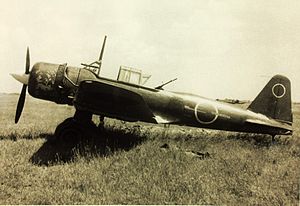| Ki-51 | |
|---|---|
 Mitsubishi Ki-51 | |
| General information | |
| Type | Light bomber/dive bomber |
| Manufacturer | Mitsubishi Jukogyo KK |
| Primary user | Imperial Japanese Army Air Service |
| Number built | 2,385[1] |
| History | |
| First flight | mid-1939 |
The Mitsubishi Ki-51 (Army designation "Type 99 Assault Plane"; Allied reporting name "Sonia") was a light bomber/dive bomber in service with the Imperial Japanese Army during World War II. It first flew in mid-1939. Initially deployed against Chinese forces, it proved to be too slow to hold up against the fighter aircraft of the other Allied powers. However, it performed a useful ground-attack role in the China-Burma-India theater, notably from airfields too rough for many other aircraft. As the war drew to a close, the Japanese began using them in kamikaze attacks. Total production was around 2,385 units.
On the day Hiroshima was destroyed by an atomic bomb, a single Ki-51 was responsible for the last Japanese sinking of a US warship, sinking USS Bullhead (SS-332) with all hands.
- ^ Angelucci, Enzo (1988). Combat aircraft of World War II. p. 26. ISBN 0-517-64179-8.